Avdat Runoff-Farm 1984-1985
It was a hot and dry summer day in the Negev desert in 1984. The Beer-Sheva bus station was busy and the air was filled with all kinds of sounds and smells. Soldiers waited at the bus gates, talking, smoking, spitting sunflower seeds on the ground, drinking soft drinks or eating falafel. As soon as a bus approached, soldiers travelling to their army bases and residents of Negev villages pushed open the doors of the luggage compartments under the buses to stow their luggage, and then boarded. The floors of the buses were quickly covered with army bags that didn’t fit into the compartments, forcing passengers to stumble to their seats. Smokers sat in the back near open windows. Strangers travelling together started talking about their lives, which was a common practice in those days.
“Ask the driver to stop at the farm,” I was told at the ticket counter when I asked for a ticket to an experimental farm at the foot of the ancient Nabatean city of Avdat, shown in the figure below. It was my first trip to the Negev highlands, about an hour’s bus ride south of Beer-Sheva. Drought-adapted shrubs were scattered in low densities across the landscape. Bedouin tents could be seen here and there. Goats, sheep and dromedars roamed the desert with their Bedouin herders. The bus passed three kibbutzim and the Jacob Blaustein Institute for Desert Research at Ben-Gurion University on the way to the picturesque Zin Valley. The bus finally entered the Avdat Valley, passed the official bus stop of the Nabatean town and came to a halt after 500 metres. The driver turned to me, said, “The farm!” and opened the front door. I thanked him, got out and was immediately immersed in the hot air under the blazing sun. The bus drove on to Mitzpe Ramon, its engine roaring until it was no longer audible. There was no wind. It was completely silent.
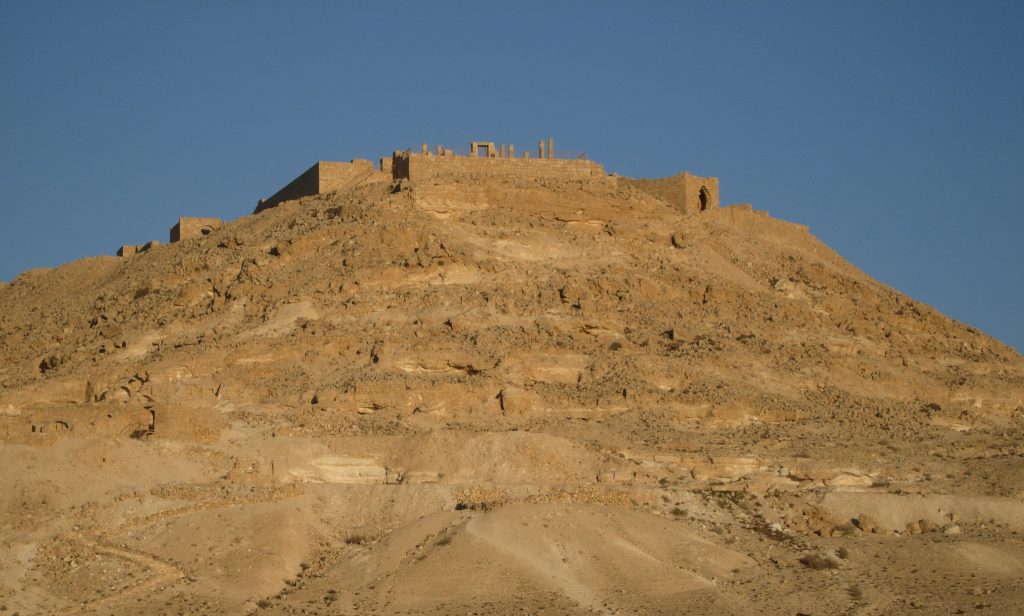
There are many people who think of deserts as inhospitable, boring, dusty places where people have no business being. Over the years I have got the impression that a significant number of them are afraid of this silence. Away from the hustle of the cities and the economic frenzy, this is a place where people come face to face with themselves. Who am I? What do I want? What is my future? These are challenging questions that cannot be escaped in the desert, if you are open to them.
I found my first experience of the desert silence at Avdat strikingly peaceful and wondered what my future might be in this unfamiliar place. Action Reconciliation and Peace Service, a German organisation dedicated to learning from the Nazi past, sent me there to see if I could work for Professor Michael Evenari, who founded the experimental farm in the late 1950s. Born Walter Schwarz in Metz in 1904, he went to school in Berlin and Marburg, studied botany at the University of Frankfurt, worked as a research assistant at the University of Prague and almost completed his habilitation at the University of Darmstadt. The rector expelled him on 1 April 1933, the day the Nazis began boycotting Jewish businesses in Germany. He continued his studies in Palestine, fought as a soldier in the Jewish Brigade of the British Army during the Second World War, became a professor of plant ecology at the Hebrew University of Jerusalem, and helped to develop its Mt. Scopus campus as Vice President and Dean of the Faculty of Natural Sciences. He became world famous for his agroecological studies of ancient Nabatean runoff farms, which he and his colleagues reconstructed in the 1950s. Professor Evenari was a member of the Friends of Action Reconciliation and Peace Service in Israel, and has had volunteers from this organisation working on his farms since the late 1960s, when diplomatic relations were established between Israel and Germany.
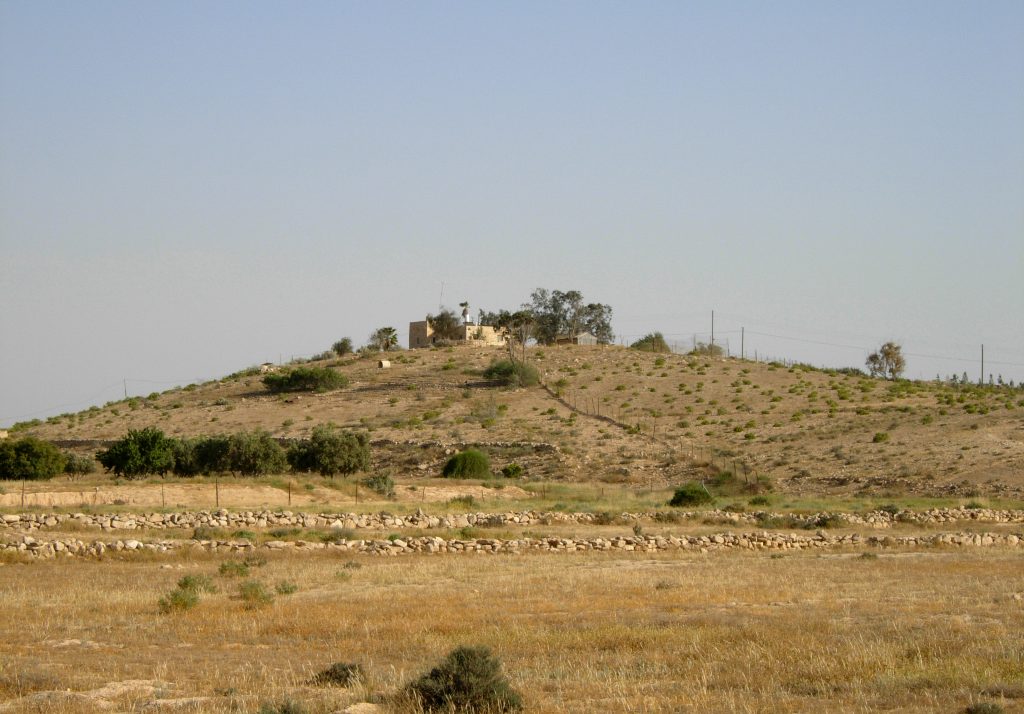
After my eyes had adjusted to the sunlight, I saw a dirt track leading up to a hill with a small wooden hut and a stone house. This must be the farm, I said to myself. Dogs started barking as I walked towards it. Another volunteer from my organisation appeared, calmed them down and greeted me. The plan was that I would replace him after his service if Professor Evenari accepted me as a volunteer. It was not difficult to convince him. After three years of agricultural work in three kibbutzim, two moshavim and two German farms, I was in good physical shape at the age of 21. My grandfather, Friedrich Langensiepen, was a Protestant priest, a member of the “Confessing Church” resistance movement and a close companion of Paul Schneider, who was tortured and murdered by the Nazis in the Buchenwald concentration camp. My childhood and youth were shaped by the countless stories my family told me about this terrible time. I was therefore sufficiently sensitised for discussions about the Nazi past.
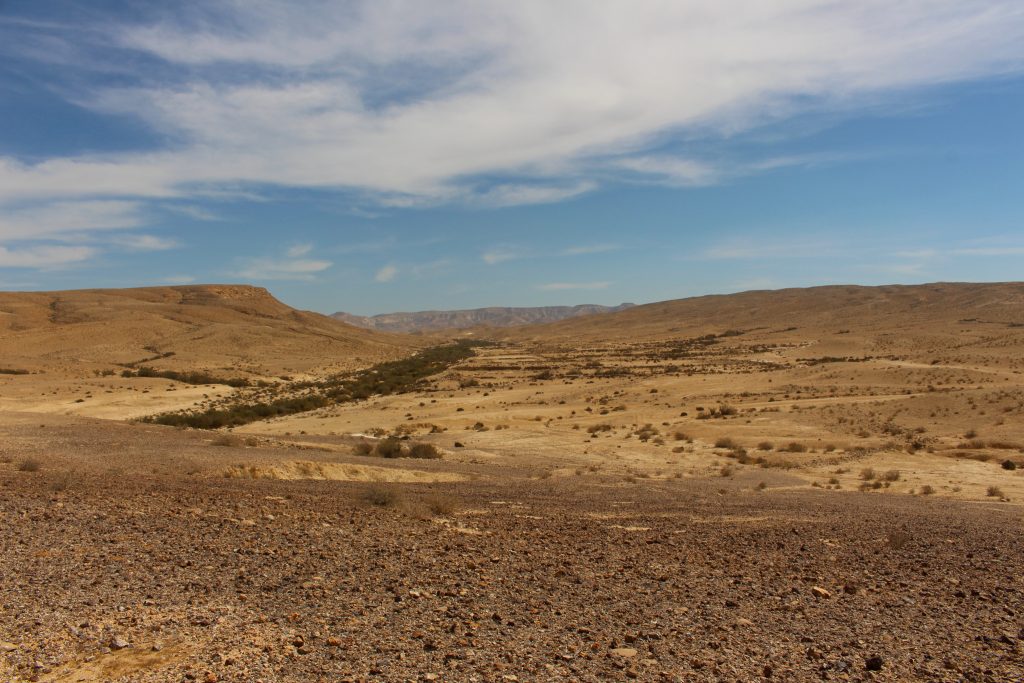
Runoff agriculture relies on infrequent rainfall during the winter months, which is ‘harvested’ from hillsides using channels and terraces carefully designed and dimensioned according to hydrological principles. Early runoff farmers were ingenious in their design more than 2000 years ago, without the tools and knowledge we have today. At the Avdat farm, several canals carried water from two watersheds to different sections of a terrace system where it was ponded to a maximum height of about 30 cm, with overflow weirs to control the amount of water allocated to each terrace. There were about two rains a year when enough water could be harvested. The plants therefore received the equivalent of about 600 mm of rain per year. The soils were fertile and had to be ploughed as soon as possible after each rain to prevent capillary water loss through evaporation into the atmosphere. The terraces were mainly planted with perennial trees such as pistachios, almonds, peaches, olives and carob, which could survive years without rain. Grapes were grown for wine production in ancient times. Dryland-adapted crops such as chickpeas, durum wheat or millet were grown on smaller areas in years with sufficient rainfall. Runoff farmers had several options for designing their farms, such as selecting suitable catchment areas, dimensioning water harvesting sections and sizing terraces. Any mistake was relentlessly punished. Terraces and canals were eroded when greedy farmers over-dimensioned water catchment areas. Trees and crops wilted if they were too small. Some old farms had diversion boxes to divert rainwater to different terraces. Management was also important. Water conduits and terrace walls had to be checked before and after each rain and repaired if necessary. Tree and crop selection had to be adapted to the hydrological conditions of the farm. Knowledge of the adaptive responses of plants to drought was an advantage. Wrong choices led to reduced yields or losses.
Space does not permit further details of the history and practice of runoff farming. Suffice it to say that ancient runoff farmers had no choice but to live with nature if they wanted to harvest trees and crops. The fact that some of their farms were run for 2000 years by different cultures in the Negev proves that they understood and respected nature’s limits and principles. Experiencing agricultural practices in the North and South, I am amazed at how little we care today. Why?
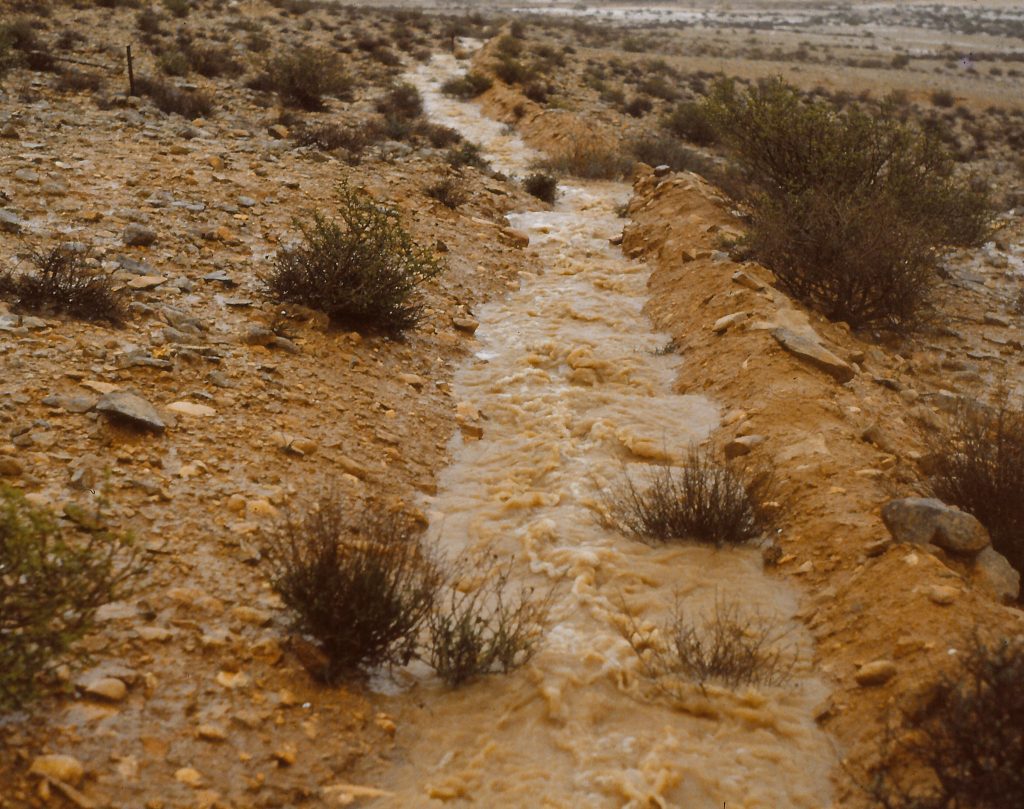
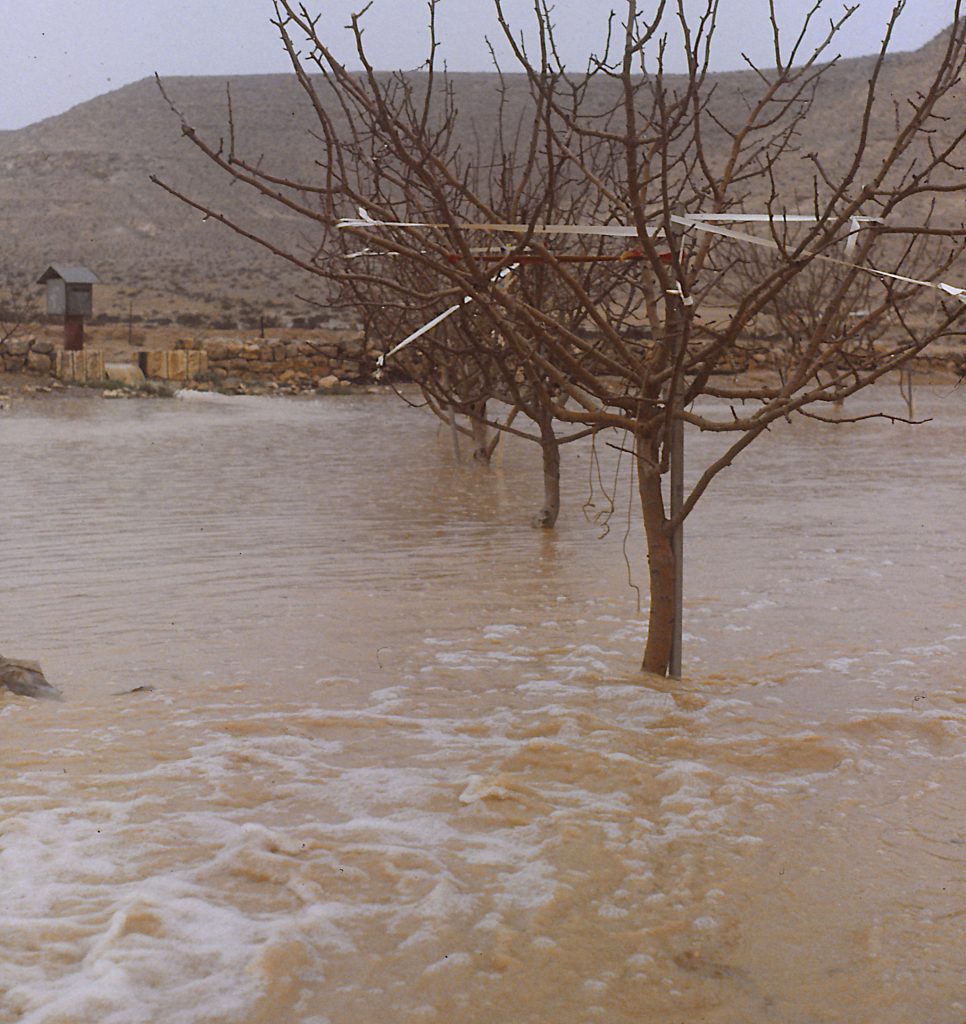
A typical day in Avdat began at dawn with the hee-haws of a donkey belonging to Abdallah, a local Bedouin who guarded our farm at night. If we didn’t wake up immediately, we would be awakened a little later by a constant pounding. Abdallah had been roasting green coffee beans on a small wood fire in a tank shell and pounding them into powder with a metal rod. That was when we really had to get up. There were about four of us most of the time. We smelled a mixture of dew, campfire, coffee and desert herbs as we left our rooms in a wooden barrack, exchanged a few words with Abdallah, took his rifle, went to the stone house to store it and then to the kitchen to drink coffee. Professor Evenari had his room next to an adjoining library with a large wooden table, which served as a meeting place and occasional laboratory for microscopy or root counting. David, our farm manager from Dimona, met us in the kitchen and discussed the day’s work with us, which included standard farm operations and scientific studies of plant-water relations. We worked from 6am until about 8am, when breakfast was served by our cook. The kitchen was occasionally overcrowded with guests from the Ecology Department of the Hebrew University, who were conducting desert ecology studies in the vicinity of the farm, or from the University of Bayreuth, who were running a large lysimeter experiment on grapevines as part of a collaborative research centre on flux control in biological systems. The main work was carried out between 9am and 2pm, except when daily cycles of plant responses to their physical environment were measured from pre-dawn until night. We ate a light meal after work, relaxed for about an hour and then met in the library around 4pm when Professor Evenari was at the farm giving seminars on every conceivable area of science and humanities. Once we discussed how to build an ideal society, another time the ecology of desert shrubs, or the history of the Nabateans, Israelites, Romans and Byzantines, or the Israeli-Arab conflicts, methods of measuring leaf gas exchange, some of which were invented on the farm, or the relationship between Jewish and Christian religions, or Bedouin culture, and so on and so forth. Adolf Hitler’s “Mein Kampf” was in the library and we were introduced to it by Professor Evenari. He was writing his memoirs “Und die Wüste trage Frucht” (in German!) during this time and gave insights into his life (English translation available: “The awakening desert”). Scientists from all over the world, practitioners from the South studying water harvesting methods, foreign politicians, students, aid workers, tourists, international television, pilgrims, religious communities of all kinds and hikers visited the farm to meet Prof Evenari and discuss their concerns. Avdat was a kind of “academic inn”, to phrase in the words of Leopold Kohr, where all kinds of people could meet in a welcoming intellectual atmosphere, discuss openly in mutual respect and deepen their understanding of a very wide range of subjects. After 33 years of study and work at various universities, I believe that we need to institutionalise such inns as additional breeding grounds for the creative, integrative thinking needed to solve the burning problems of our time.
The seminars usually lasted from 4pm to 6pm, after which dinner was served and discussions continued. Then we retired, lit a fire, talked, watched the stars, the Milky Way and shooting stars, undisturbed by light pollution, and gradually became tired and quiet. Professor Evenari played the recorder in his room. Abdallah came. Crickets chirped. Snakes occasionally chased mice in the attic of our wooden hut as we fell into a deep sleep until another day began…
